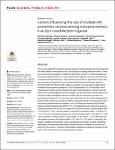| dc.identifier.citation | Betunga B, Atuhaire P, Nakasiita C, Kanyamuneza C, Namiiro P, Tugume J, et al. (2023) Factors influencing the use of multiple HIV prevention services among transport workers in a city in southwestern Uganda. PLOS Glob Public Health 3(3): e0001350. https://doi.org/10.1371/ journal.pgph.0001350 | en_US |
| dc.description.abstract | The use of multiple HIV prevention services has been found to decrease the risk of acquiring
HIV when tailored to individuals at risk of HIV exposure, including transport workers. There-
fore, we assessed the uptake of multiple HIV prevention services (�2) and associated fac-
tors among transport workers in a city in Southwestern Uganda. This cross-sectional study
comprised motorcycle taxi riders, motor vehicle and truck drivers, aged 18 to 55 years who
were selected and responded to an interviewer-administered questionnaire, between
November 2021 and February 2022. Data was analyzed using descriptive statistical and
modified Poisson regression analyses. Out of 420 participants, 97.6% were male, with a
median age of 28 years and the majority were aged <34 years (84.6%). Overall, less than
half (45.3%) of the participants had used multiple (�2) HIV prevention services within a one-
year period. Many participants had used condoms (32.2%) followed by voluntary HIV
counseling and testing (27.1%), and safe male circumcision (17.3%). Most participants who
tested for HIV had ever used condoms (16.2%), followed by those who received safe male
circumcision and had ever used condoms (15%), and those who tested for HIV and had
started on antiretroviral therapy (ART) (9.1%). In the adjusted model, factors that were sig-
nificantly associated with the use of multiple HIV prevention services included religion (aPR
= 1.25, 95% CI = 1.05–1.49), the number of concurrent sex partners (aPR = 1.33, 95% CI =
1.10–1.61), prior HIV testing and awareness of HIV serostatus (aPR = 0.55, 95% CI = 0.43–
0.70), awareness of HIV prevention services (aPR = 2.49, 95% CI = 1.16–5.38), and finan-
cial payment to access HIV services (aPR = 2.27, 95% CI = 1.47–3.49). In conclusion, the
uptake of multiple HIV prevention services among transport workers remains suboptimal.
Additionally, individual behavioral factors influence the use of multiple HIV services com-
pared with other factors. Therefore, differentiated strategies are needed to increase the utili-
zation of HIV prevention services among transport workers | en_US |

